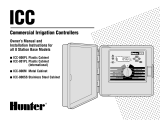
General Installation Instructions
It is very important that the decoders be installed
properly since most of the system will be underground
and therefore not easy to access should any alterations
or repairs be required� Refer to instructions below for
proper installation techniques�
Stripping The Maxi Wire
!NOTE: Use only a U�F� safety stripper tool as
manufactured by King Safety Products to
remove the outer PE jacket on the Maxi wire�
It is the only tool that will remove the outer
jacket of the Maxi wire while minimizing
potential damage to the insulation on the
inner conductors�
1. Slide 4” to 6” of the Maxi wire out through the hole
in the back of the safety stripper�
2. Make sure the cable is on it’s edge and gently
apply even pressure with your thumb on top of
the tool�
3. Firmly draw the tool back along the cable in one
motion while maintaining light pressure with
your thumb�
4. Turn the cable on it’s opposite edge and repeat
the process�
5. Clip off the loose outer pieces of PE jacket with
linesman’s pliers�
6. Remove the inner insulation with a properly sized
wire stripper for the gauge cable you are working
with to make the Maxi wire splice, Red to Red and
Black to Black�
!NOTE: It is advisable to test the above
method on a small piece of scrap Maxi wire
to familiarize yourself with the amount of
pressure to apply consistently remove a very
thin strip of the jacket in one motion without
damaging the inner insulation�
Wire Splices
1. Gently twist two wires together using linesman’s
pliers� No more than four twists are required�
!NOTE: Twisting the wires in excess can
fracture the conductors�
2. Firmly hand-tighten the appropriate size wire nut
onto the twisted wire and push it into the direct
burial splice connector as far as possible�
3. Snap the cap securely�
Valve Boxes at Splices
1. Place splices in a 12” x 18” rectangular valve box�
2. Provide three to four feet of excess wire in the
valve box so that splices may easily be brought
above ground for troubleshooting�
3. Clearly mark all wire splices with their routing
direction or the holes they feed�
Decoder Controller Installation
Decoder Wiring Procedure - Primary Path
1. Connect red wire of Equip side of MSP-1 to
terminal 1A of DIB�
2. Connect black wire of Equip side of MSP-1 to
terminal 1B of DIB�
3. Connect red wire of Line side of MSP-1 to red wire
of Primary path�
4. Connect black wire of Line side of MSP-1 to black
wire of Primary path�
!NOTE: Color coding of the wires can be
an invaluable troubleshooting tool in the
future�
5. Connect the other end of the red wire of the
Primary path to one (1) of the blue decoder
wires�
6. Connect the other end of the black wire of the
Primary path wire to the other blue decoder wire�
!NOTE: If you are continuing the wire path to
another decoder, then connect a new wire to
the decoder in steps 5-6 and run the other
end of the new wire to the next decoder�
PAR+ES Installation Manual14





















